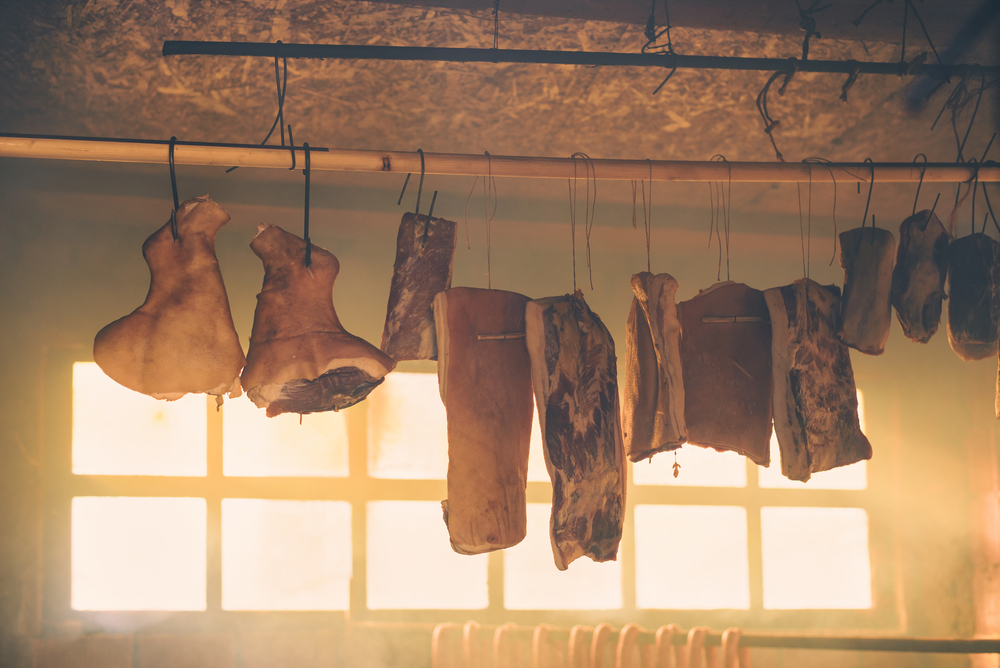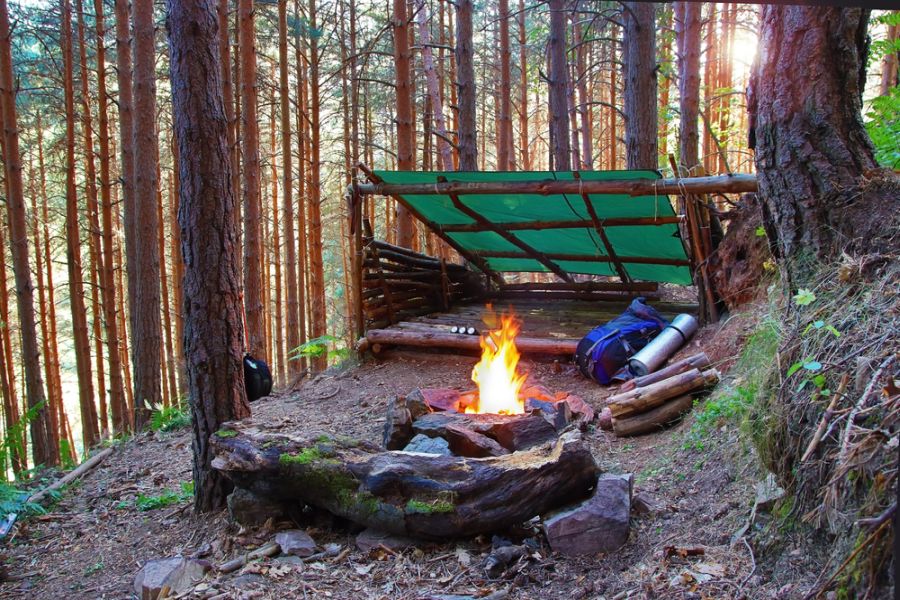Food preservation is central to prepping. We buy food to stockpile, but many of us preserve our own food, too; either food that we buy or food that comes from our own gardens. Yet of all the foods that we eat, the hardest to preserve is meat. A large part of that is because meats naturally have more bacteria in them than fruits and vegetables do. But if we are going to make it through any survival situation, meat has to be part of our diet.
Our bodies need three macronutrients to survive: carbohydrates, fats, and proteins, preferably animal proteins, as it is difficult to get all the amino acids for building proteins from plants. In survival, especially in short-term survival, a diet that focuses on those three makes sense, temporarily ignoring all the micronutrients that nutritionists love to talk about. Yet I see a lot of people in the prepper space who focus on stockpiling foods that give us carbohydrates and some fats while ignoring proteins. You’ve probably seen those articles where people talk about building a one-year stockpile for $100.
Nutritionally speaking, we can’t really do without any of the three macronutrients for very long. Carbohydrates and fats both provide us with energy for our bodies to function, with our metabolism breaking those nutrients down into simple sugars that muscles burn for energy. The main difference is that fats take much longer to break down than carbohydrates, so they provide energy over a longer period of time, giving us that second wind.
In addition to the energy that we receive from carbohydrates and fats, our bodies are able to use the energy we’ve got stored up as fat within our own bodies. Let’s face it, many of us are much fatter than we should be, largely due to a sedentary lifestyle mixed with eating too much of the wrong foods. But that doesn’t mean that we can just live off those fat reserves. The fat in our bodies doesn’t do anything to store up many of the other nutrients that we need.
One of those key nutrients is protein. The problem with going without protein is that the body needs protein to build new cells. There is no mechanism in our bodies to store protein, so what the body has to do in order to create new cells is to start cannibalizing healthy cells to get protein out of them. This mostly leads to muscle loss, but it can affect other areas of our bodies as well. Lack of protein in the diet slows the metabolism (the chemical process by which everything in our bodies works), mental focus diminishes, and food cravings increase.
While we can get all nine essential amino acids (there are a total of 20) needed for our bodies to synthesize proteins from plants, that requires eating plants that provide all nine essential amino acids, those are buckwheat, chia seeds, hemp seeds, and spirulina. Those aren’t exactly common grains in most people’s prepping stockpiles. They’re more likely to be found in a health food grocery store.
So that brings us back to meat. While a lot of preppers think that they’ll be able to hunt for food, I’ve always held that the game population will become scarce very quickly in any major disaster. Considering that, we have to rely on preserved meat, whether that be meat that we buy already preserved, grow the animals that the meat comes from, buy animals from farmers, or hunt for those animals.
Knowing how to preserve that meat and having the necessities for doing so is essential to long-term survival. Should any of us be fortunate enough to kill any large game or even to barter for a steer, we’re going to have to preserve the meat before it can go bad. Meat doesn’t have a very long shelf life at room temperature, and that shelf life gets even shorter when it’s hot, and there’s no air conditioning.
Salt – Nature’s Preservative
Any means of preserving meat is going to require salt; it doesn’t matter if you’re talking about canning, smoking, or dehydrating. Yet most preppers only stockpile enough salt to use as seasoning. I’ve got over 100 pounds of salt, which I was able to buy fairly inexpensively. In addition, I live close to the ocean, where I can gather saltwater to extract my own sea salt.
Salt acts as a preservative due to a chemical process called osmosis. The principle of osmosis holds that a solvent, in this case, water, will move across a semi-permeable membrane from the side of the membrane that has a lower concentration of minerals (salt in our case) to the side that has a higher concentration of minerals. On a more basic level, when there is salt present, water will come out of the cells of the meat, passing through the membrane of the cell walls, to dilute the saltiness of that salt.
When the water passes out of the meat cells, it also comes out of the bacteria in the meat, to a point where it kills the bacteria by dehydration. Bacteria need a moist environment to survive, and salt creates a very hostile environment for it.
We can see this action, at least on a large scale, by putting a piece of meat on a plate and then sprinkling a large amount of salt on it. Within moments the salt will become saltwater, as water comes out of the meat, following the rules of osmosis.
Using Salt when Dehydrating Meat
It is theoretically possible to dehydrate meat, essentially making beef jerky, without salt. The fact that the meat is dehydrated is sufficient to dehydrate the meat alone. Nevertheless, meat to be dehydrated is usually soaked in a salty, flavored marinade before dehydration. This not only adds flavor to the resulting jerky but it also helps to preserve the meat, should the meat come into contact with water.
Dehydrated meat is dry enough to present a hostile environment to bacteria, preventing their growth. Nonetheless, should that meat come into contact with water, bacteria could start growing in it again. By salting the meat, we add a second layer of protection to the meat, in that the moist meat will be salty, which will help keep the moisture out of the meat itself and draw moisture out of any bacteria that come into contact with the meat.
Please note that meat is generally dehydrated at 165°F, which is hot enough to kill the bacteria, even without dehydrating it. Dehydrating it at a lower temperature may not be safe, as some bacteria may survive. But any temperature over 158°F will kill bacteria.
Using Salt when Curing Meat
We don’t cure meats often today, not even in the prepping community. Nevertheless, it is another means of preserving meat. Most of the meats we are familiar with in our delicatessens were originally considered cured meats back in the Middle Ages. Curing meat was both a way of preserving it and turning tougher meat cuts, which might not otherwise be used, into usable meat products.
Other types of food products made from animal flesh can be categorized as cured meats, even though they are not deli meats. Saltfish, a common preserved fish product from the northern parts of Europe, is a cured meat, even though it appears quite different than our deli meats.
The process of curing meat is one that depends on the use of salt and the principle of osmosis. Special salt is used that contains nitrate. The salt draws the moisture out of the meat, killing the bacteria in the process. Care must be taken in the amount of nitrite added to the salt, as excessive amounts of nitrates can be dangerous when consumed. Only make cured meats using packaged curing salt, following proven recipes.
The curing process is typically done in a cold environment, like a refrigerator. That’s to protect the meat from bacteria while it is curing. But once the meat has been cured, it can be stored in the open, without danger.
Curing can be broken down into two categories: wet and dry curing. Wet curing requires the use of brine (a supersaturated salt solution), while dry curing requires merely the use of salt, either packing the meat in salt or adding large quantities of salt to a mixture containing the meat. This is how many types of salami are made.
One thing to be cautious about with cured meats is that many of our cured meats today aren’t properly cured for long-term preservation without refrigeration. Don’t assume that just because you bought some salami or even some cured bacon, it is safe to leave it out. If you’re planning on keeping some cured meats as part of your prepper stockpile, make a trial run with a small quantity first to ensure that it will stay safe.
Salt and Smoking Meat
Traditionally, meats that are to be smoked are soaked in brine first, allowing them to absorb the salt. While it is possible to smoke meats without this step, the salt also adds desired flavor to the meat. It also helps keep the meat from drying out excessively and helps preserve it, even before the heat and smoke get to the meat.
Most of the smoked meat today is only cold smoked, at a temperature less than 100°F. All that’s happening is infusing the meat with the smoked flavor at this temperature. It isn’t working to preserve the meat. Hot smoking, at a temperature of 126 to 176°F, depending on the type of meat being smoked, is needed for the purpose of preserving the meat.
Besides cooking the meat and drying it out somewhat, the process of smoking the meat converts the collagen protein in the outer part of the meat into a layer called a pellicle. This layer is basically impermeable to bacteria, protecting the meat from spoiling.
The big question is just how long meat can last when smoked. There was a time when smoked meats were kept and considered safe to eat for a prolonged period of time. Little data exists on this today, as most of our smoking is done to add flavor rather than preserve it. You will have to do some experimentation on that yourself to determine how long your own smoked meats will last. But only do it if you have brined the meat and hot smoked it sufficiently to create the pellicle.
Even when meats are properly smoked for preservation, one problem is that cutting the meat exposes parts of the meat that are not properly smoked. Those parts of the meat can begin to spoil as bacteria multiply in them.
I saw a house once in one of those living history museums, which had a kitchen fireplace and chimney that was the size of a dining room table. The sides of the chimney had meat hooks built into it so that slabs of meat could be hung there, where they would constantly be being smoked. The idea was that slabs of meat that were brought down and had pieces cut off them could be hung back up in the chimney, allowing the cut area to smoke over, keeping the meat preserved.
Using Salt when Canning Meat
Salt is generally used whenever we can meat, although it is not actually required. Canning is about the perfect food preservation method possible; processing food to can kills the bacteria in the food and then seals it in an impervious container, where nothing can get to it. As long as the container remains undamaged and intact, the food inside will remain safe to eat, including meat.
The one big difference in canning meats is that the meat has to be canned at a higher temperature than other foods do. This is because meat has more bacteria in it than other foods do. So the higher temperature is to kill the bacteria. But in order for that to happen, the use of a pressure canner, essentially an oversized pressure cooker, is needed.
Of all the means of preserving meat, canning is the most secure. On the flip side of that coin, canning tends to affect the flavor of the meat the most, in ways that many people don’t like. Nonetheless, for long-term meat storage, canning is the most secure.







































































One of the problems with smoking meats is that all around you, people will know that you have meats. Canning with a pressure canner over a fire could take all day if there is wind. There were other means of preserving meat, pemmican was a useful way of using up dried meat. It’s not the most tasty, but it’ll do it you can make enough.
As I have “high blood pressure”, the problem with most methods for preserving meat is the heavy use of salt. So, instead, I use “freeze drying” to preserve meat. First, I cook my meat with little to no salt on my Traeger. Next I slice or chunk the meat to fit on the freeze drying trays. Then I freeze dry the meat which usually takes about 24-48 hours on my Harvest Right machine. Next, I seal the resulting freeze dried meat into Mylar bags with oxygen absorbers. Finally, I store the sealed bags in a cool dry portion of my basement. If I am doing this right, the meat should be good for 5-25 years in storage.
Do you have any go-to books that you use to learn about these methods & recipes? I do not accept digital downloads, sorry.